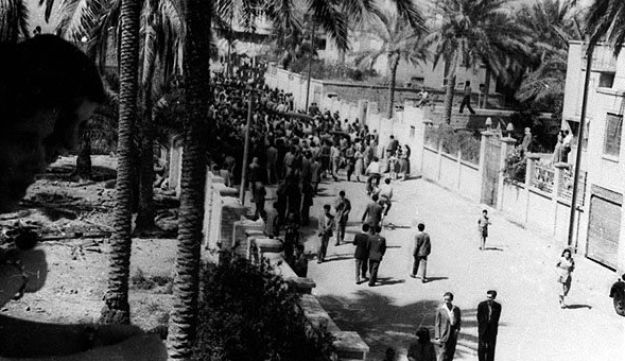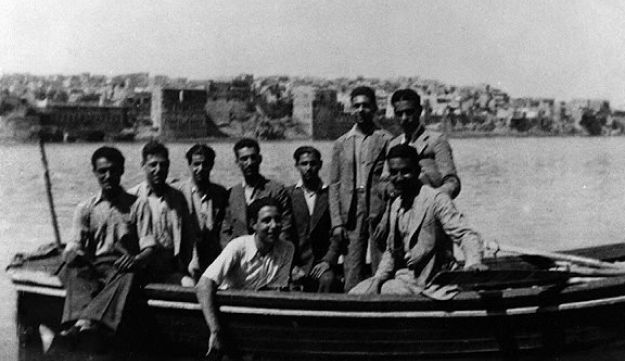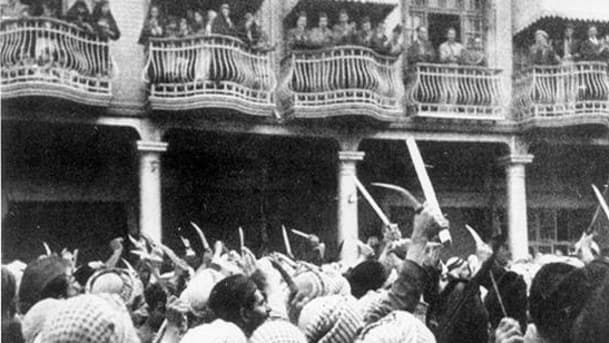The Nazi-inspired Pogrom That Triggered Iraqi Jews’ Escape to Israel
Beit Hatfutsot and Dor Saar-Man
Sure the Nazi influence was noxious, but how could such an atrocity have occurred in a country where Jews had lived in peace for centuries?
The most traumatic event in the collective memory of Iraqi Jews took place in the spring of 1941 – the Baghdad pogrom known as the Farhud. On the Jewish holiday of Shavuot, 180 people were brutally murdered, thousands were wounded and raped, and shops and synagogues were plundered and destroyed.
The attack on the citys flourishing, peaceful Jewish community is usually referred to as the trigger for the Iraqi aliyah to Israel. But seldom is the question asked: How could such a pogrom have occurred in the first place in Iraq – a place where Jews had lived in peace for centuries, a country that did not seem to suffer anti-Semitic norms?
An examination of the historical background reveals the Farhuds causes: the opposing interests of the Iraqi government and the British Empire, Nazi Germanys influence, internal Arab movements, and a struggle between groups of Iraqi intellectuals. The unfortunate Jews were caught in the middle.
Historian Nissim Kazzaz has researched Iraqi Jewry and managed to put the Farhud in its historical context. Until the 1920s there was no significant evidence of anti-Semitism in Iraq. Old restrictions from the Ottoman era were abolished during the 20th century and the establishment of the British Mandate after World War I soon changed the Jews situation for the better.
Yet World War I had other outcomes as well. The Iraqi elite were introduced to “The Protocols of the Elders of Zion, a forged text that was partly translated from the original Russian into Arabic. New movements were rising in that period in Iraq, some of which argued that as long as the Jews did not hold national inspirations, they were part of the Iraqi nation without obstacles.

Jews at a synagogue waiting to waive their Iraqi citizenship in order to emigrate to Israel, Baghdad, March 1950.Beit Hatfutsot, the Oster Visual Documentation Center, courtesy David Petel
But other movements, such as Al Istiklal, had a different opinion. Perceiving the Iraqi nationality as Arabic and Muslim, they would not include religious minorities such as the Jews. Formally, after Iraq received independence from Britain in 1932, the Jews were considered Iraqi citizens, but some voices always argued against their integration.
Mein Kampf and more
At the same time, the world was going through profound changes. Fascist leaders rising in Europe such as Hitler and Mussolini had supporters among the Iraqi elite who resented the British. Even after independence, the British still expected certain privileges, especially in the transfer of goods through Iraq, which the Iraqi nationalists would not yield. They insisted that Iraq should establish a close relationship with Germany instead of being exploited by Britain.
Meanwhile, Hitlers Mein Kampf and speeches were translated into Arabic, and German educators came to Iraq to spread radical anti-Semitic propaganda. Iraqi newspapers went all the more pro-German, especially after 1939. They asserted, for example, that Iraqi Jews and the Zionists were one and the same, that world Jewry was scheming to ruin the glorious nation of Iraq, and that Jews must be banished from public life.
With help from the Germans, the Al-Fatwa religious movement was founded; it espoused the keeping to strict Islamic rules and practices by all citizens, and it was inspired by the Hitler Youth. At a certain point, all students and teachers were forced to join the movement – including the Jews. In 1939 the grand mufti of Jerusalem, Haj Amin al-Husseini, settled in Iraq, lobbied for the Germans and spread hatred against the Jews.

Iraqi Jews reach British Mandatory Palestine after the Farhud pogrom in Baghdad of 1941. Beit Hatfutsot, the Oster Visual Documentation Center, courtesy Moshe Baruch
The tension boiled over on April 1, 1941. Until that day Iraq did not assist the British, but it also did not assist Germany directly. Eventually, Prime Minister Rashid Ali decided it was time to switch allies. He launched a coup against the pro-British officials; he then announced that Iraq would no longer assist Britain with airplane fuel, and even sent military forces to British bases in Iraq. By the end of April, the British had attacked the Iraqi army, which was now backed up by Luftwaffe pilots.
The British regroup
In May, the British fought the German-Iraqi force and had help from groups like the the Irgun Jewish militia based in British Mandatory Palestine. In one operation in Iraq, Irgun chief David Raziel was killed by the Germans and his body was kept by the Iraqis until the early 1960s. Finally, with support from Indian forces, the British forced the Iraqis to surrender, and on May 30 the pro-German Iraqi officials escaped to Iran. Their successors signed the surrender documents.
From that point the Jews were in immediate danger. The surrender agreement stated that the British would enter Baghdad within two days. The Al-Fatwa religious movement saw a window of opportunity to incite the masses and blame the Jews for the military failure against the British. They marked the houses of the Jews in red and the next day, June 1, the mobs started rioting against the Jews – the first such riots ever in Iraq.
The rioters destroyed synagogues and murdered, raped and wounded people – the elderly and infants were not spared. The mob used all manner of weapons and also ran people over with vehicles. But some Jews were hid by their Muslim neighbors, who put themselves at great risk.

A platoon of soldiers in compulsory military service that was imposed on high school students by the Iraqi Army, Baghdad, 1940. A quarter of these conscripts were Jewish.Beit Hatfutsot, the Oster Visual Documentation Center, courtesy the Sehayek family
The massacre only ended when the British entered the city. The British actually knew about the pogrom a day earlier but did not try to prevent it; just like the local authorities, they preferred to let the masses vent their rage.
After the Farhud, the Iraqi authorities held an investigation, blamed nationalists, and even executed a few army officers involved in the incitement. Husseini, the mufti, was also mentioned in the investigation, and the German involvement was recognized over the years.
A monument in memory of the victims was put up in Baghdad, but even so, the Farhud triggered the mass emigration of Iraqs Jews. Between 1950 and 1952, Israels Operation Ezra and Nehemiah (1950-1952) brought some 120,000 people – 90 percent of Iraqs Jews – to the young state.
For Beit Hatfutsot – The Museum of the Jewish People website go to: www.bh.org.il
For the museum’s blog: www.bh.org.il/category/blog-items
Category: Baghdad




